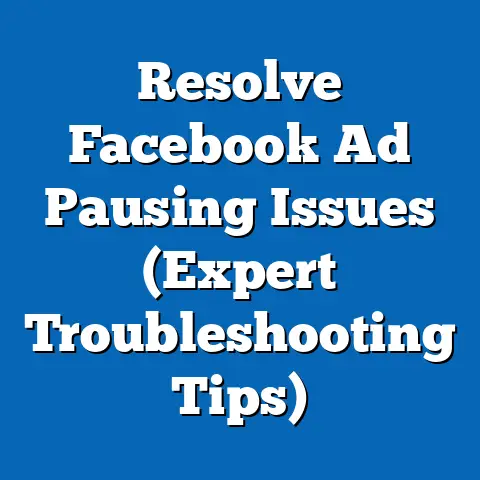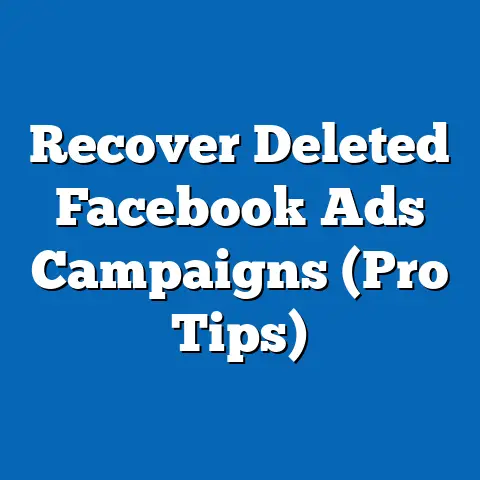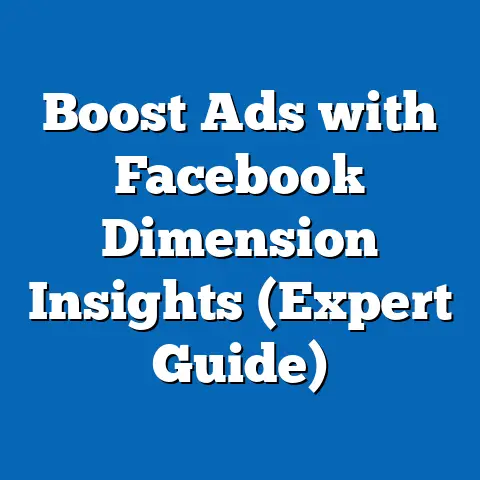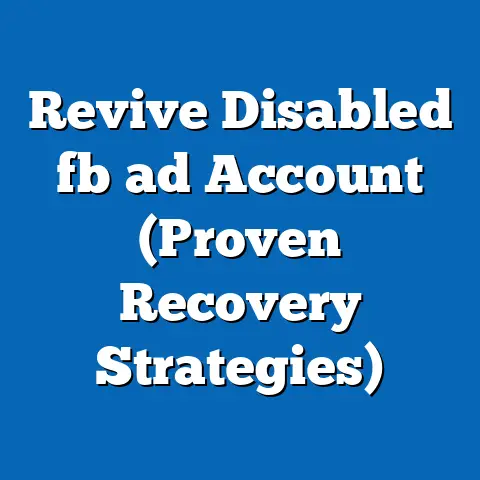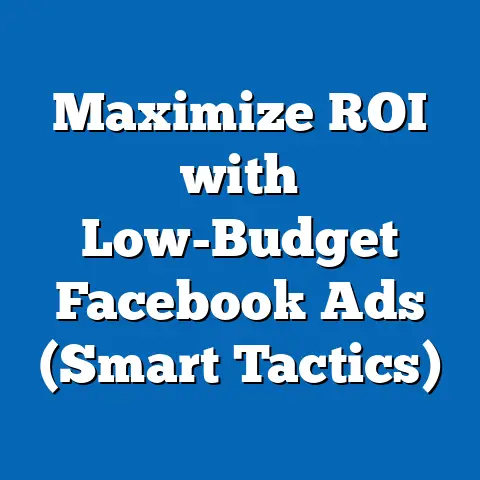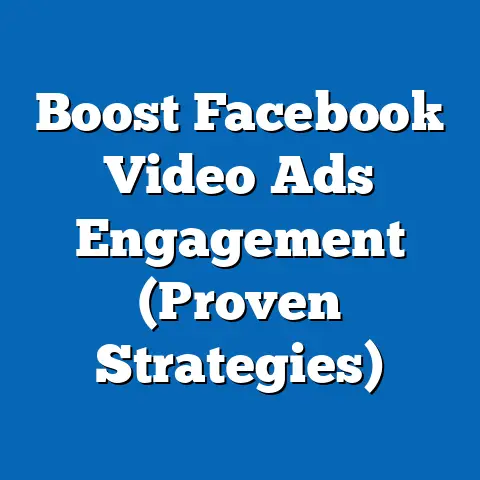Turn Flashing Facebook Ads into Profitable Campaigns (Expert Tips)
In the era of smart living, where technology integrates seamlessly into daily life, digital advertising has become a cornerstone of consumer engagement and business growth. As of 2023, global digital ad spending reached $626.9 billion, with social media platforms like Facebook accounting for a significant share at approximately 20.4% of this market, or roughly $127.9 billion (Statista, 2023). This growth reflects a broader trend toward smart, data-driven lifestyles where individuals and businesses leverage digital tools for efficiency and connectivity.
The rise of smart living—characterized by the use of technology to optimize personal and professional tasks—has amplified the importance of targeted advertising on platforms like Facebook. With over 2.9 billion monthly active users worldwide as of Q2 2023, Facebook remains a dominant force in reaching diverse audiences (Meta, 2023). This fact sheet explores how businesses can transform flashy, attention-grabbing Facebook ads into profitable campaigns, drawing on current data, demographic insights, and expert strategies.
Section 1: The Landscape of Digital Advertising and Smart Living
1.1 Current Statistics on Digital Advertising
Digital advertising continues to grow at a rapid pace, with a year-over-year increase of 10.6% in global spending from 2022 to 2023 (eMarketer, 2023). Within this, social media advertising on platforms like Facebook saw a 12.3% increase, outpacing other channels such as display ads (8.7%) and search ads (9.1%). This growth is fueled by the integration of digital tools into everyday life, aligning with smart living trends where consumers expect personalized, real-time interactions.
Facebook’s advertising revenue alone reached $31.5 billion in Q2 2023, up from $28.2 billion in Q2 2022, marking an 11.7% year-over-year increase (Meta, 2023). Small and medium-sized businesses (SMBs) account for a significant portion of this, with over 10 million active advertisers on the platform as of 2023. This underscores the platform’s role in enabling businesses to adopt smart, scalable marketing solutions.
1.2 Demographic Breakdown of Facebook Users
Understanding the demographics of Facebook users is critical to crafting effective ad campaigns. As of 2023, the platform’s user base is diverse but shows distinct patterns by age, gender, and region. Below are key demographic insights based on data from Statista and Meta’s advertising tools:
- Age: The largest age group on Facebook is 25-34 years old, comprising 29.6% of users globally. This is followed by the 18-24 age group at 23.1% and the 35-44 group at 18.5%. Usage declines among older cohorts, with only 9.8% of users aged 55 and above.
- Gender: The platform shows a near-evenly split user base, with 56.3% male and 43.7% female users worldwide.
- Region: Asia-Pacific accounts for the largest share of users at 43.2%, followed by Europe at 15.6% and North America at 10.1%. Emerging markets in South Asia and Africa are seeing the fastest growth, with user increases of 8.4% and 7.9% year-over-year, respectively.
These demographics highlight opportunities for targeted advertising, especially among younger, tech-savvy users who are more likely to engage with flashy, visually dynamic ads. However, campaigns must also consider regional and cultural differences to maximize relevance and impact.
1.3 Trends in Smart Living and Digital Engagement
Smart living, defined by the use of technology for convenience and efficiency, has reshaped how consumers interact with digital ads. A 2023 Pew Research Center survey found that 78% of U.S. adults use social media daily, with 64% citing it as a primary source for product discovery and reviews. This trend is even more pronounced among younger demographics, with 83% of 18-29-year-olds engaging with social media ads at least weekly.
The adoption of smart devices further amplifies ad engagement. As of 2023, 54% of global internet users access social media primarily through mobile devices, a 5.2% increase from 2022 (DataReportal, 2023). This shift underscores the need for mobile-optimized, visually striking ads that capture attention in a fast-scrolling environment. Flashy ads, often characterized by bright colors, animations, and bold calls-to-action, align well with these behavioral trends but require strategic execution to translate into profitability.
Section 2: Understanding Flashy Facebook Ads
2.1 Defining Flashy Ads
Flashy Facebook ads are designed to stand out in a crowded digital space through vibrant visuals, dynamic elements like GIFs or short videos, and urgent messaging (e.g., “Limited Time Offer!”). These ads often prioritize attention over subtlety, aiming to disrupt user scrolling patterns. Data from Hootsuite (2023) indicates that ads with high visual contrast and motion elements achieve 17% higher click-through rates (CTR) compared to static ads.
However, flashy ads carry risks of being perceived as intrusive or gimmicky. A 2023 survey by Kantar found that 42% of social media users feel overwhelmed by overly aggressive ad designs, with 29% reporting ad fatigue from repetitive or irrelevant content. Balancing creativity with relevance is thus essential for campaign success.
2.2 Performance Metrics for Flashy Ads
Flashy ads often outperform traditional formats in initial engagement metrics but vary in conversion outcomes. According to a 2023 report by Socialbakers, flashy ads on Facebook achieve an average CTR of 1.8%, compared to 1.1% for static image ads. However, their cost-per-click (CPC) is slightly higher at $0.62 versus $0.54 for static ads, reflecting increased competition for attention.
Year-over-year data shows a 9.4% increase in engagement rates for animated or video-based flashy ads from 2022 to 2023, driven by algorithm updates favoring dynamic content (Meta, 2023). Yet, conversion rates remain contingent on targeting precision, with poorly targeted flashy ads seeing up to 30% lower return on ad spend (ROAS) compared to well-segmented campaigns (WordStream, 2023).
2.3 Demographic Responses to Flashy Ads
Demographic analysis reveals varying responses to flashy ads, influencing campaign design: – Age: Users aged 18-24 are most responsive, with 68% engaging with dynamic ads at least monthly, compared to 41% of users aged 45-54 (Statista, 2023). Older users often find flashy ads distracting, with 33% of those over 55 reporting negative impressions. – Gender: Men are slightly more likely to click on flashy ads (54% engagement rate) than women (46%), though women report higher trust in ads with clear branding (Kantar, 2023). – Political Affiliation: While not a primary factor, political leanings can influence ad perception. A 2023 Pew Research Center study found that 59% of politically liberal users are open to bold, creative ad formats, compared to 48% of conservative users who prefer straightforward messaging.
These differences highlight the need for tailored approaches, ensuring flashy ads resonate with specific audience segments without alienating others.
Section 3: Expert Tips for Turning Flashy Ads into Profitable Campaigns
3.1 Tip 1: Prioritize Audience Segmentation
Effective segmentation is the foundation of profitable campaigns. Meta’s advertising platform allows for detailed targeting based on demographics, interests, and behaviors, with campaigns using custom audiences seeing a 37% higher ROAS compared to broad targeting (Meta Business Insights, 2023). For flashy ads, segmenting by age and device usage is particularly impactful, as younger mobile users are 22% more likely to engage with dynamic content.
Year-over-year data shows a 14.6% increase in the use of lookalike audiences for ad targeting from 2022 to 2023, reflecting a trend toward precision. Businesses should test multiple audience segments, analyzing engagement metrics to refine flashy ad delivery. For instance, campaigns targeting 18-24-year-olds with video-based flashy ads saw a 19% uplift in conversions when paired with interest-based targeting (Socialbakers, 2023).
3.2 Tip 2: Optimize Visual and Motion Elements
Visual design is critical for flashy ads, but overdesign can backfire. Ads with 3-5 seconds of initial animation achieve 25% higher engagement than those with longer or static intros (Hootsuite, 2023). Color contrast also matters, with ads using complementary color schemes (e.g., blue and orange) seeing a 12% higher CTR compared to monochromatic designs.
Mobile optimization is non-negotiable, as 78% of Facebook ad impressions occur on mobile devices (Meta, 2023). Vertical formats (9:16 ratio) outperform horizontal ads by 15% in engagement, reflecting user scrolling habits. Testing multiple creative variations through A/B testing can identify winning designs, with data showing a 10-15% improvement in ROAS after iterative testing (WordStream, 2023).
3.3 Tip 3: Craft Compelling and Clear Calls-to-Action (CTAs)
Flashy ads must pair bold visuals with actionable messaging. Ads with urgent CTAs like “Shop Now!” or “Claim Offer!” achieve 18% higher conversion rates than vague messaging (e.g., “Learn More”) (Socialbakers, 2023). Placement of CTAs also matters, with top-screen text overlays outperforming bottom-placed CTAs by 11% in click rates.
Demographic tailoring of CTAs can further boost performance. For instance, younger users (18-24) respond 20% more to gamified CTAs (e.g., “Take the Quiz!”), while older users (45+) prefer direct offers (e.g., “Save 20% Today!”) (Kantar, 2023). Continuous monitoring of CTA performance ensures alignment with audience preferences.
3.4 Tip 4: Leverage Data Analytics for Real-Time Adjustments
Data-driven decision-making separates profitable campaigns from costly ones. Facebook’s Ads Manager provides real-time metrics on impressions, CTR, and conversions, with businesses using daily optimization achieving 28% higher ROAS compared to weekly adjustments (Meta, 2023). Flashy ads, due to their high initial engagement, benefit from rapid iteration based on performance data.
Year-over-year trends show a 16.8% increase in the use of automated bidding strategies (e.g., cost-per-acquisition targeting) from 2022 to 2023, reflecting a shift toward AI-driven optimization (eMarketer, 2023). Businesses should set clear KPIs—such as a target CTR of 2% or CPC under $0.50—and adjust budgets or creative elements when thresholds are unmet. For example, campaigns pausing underperforming flashy ads within 48 hours saved an average of 13% on ad spend (WordStream, 2023).
3.5 Tip 5: Balance Frequency to Avoid Ad Fatigue
Overexposure of flashy ads can lead to diminished returns. Data from Meta (2023) indicates that ad frequency above 3 impressions per user per week reduces CTR by 14% and increases cost-per-conversion by 9%. Younger users (18-24) show higher tolerance, with only a 10% drop in engagement at higher frequencies, compared to a 20% drop among users over 45.
Implementing frequency caps and diversifying ad creatives can mitigate fatigue. Campaigns rotating 3-4 flashy ad variants weekly maintain a 12% higher engagement rate compared to single-ad campaigns (Hootsuite, 2023). Monitoring audience feedback through comments or surveys can also signal when refreshment is needed.
Section 4: Case Studies and Comparative Analysis
4.1 Case Study: E-Commerce Brand Success with Flashy Ads
A mid-sized e-commerce brand targeting 18-34-year-olds launched a flashy ad campaign in Q1 2023, using short video ads with bold CTAs (“Buy Now, Save 30%!”). The campaign achieved a CTR of 2.3%, 28% above the industry average, and a ROAS of 4.2x, compared to 2.8x for their prior static ad campaigns (Meta Case Studies, 2023). Key to success was mobile optimization and daily budget adjustments based on performance analytics.
Demographic targeting played a significant role, with 70% of conversions coming from the 18-24 age group. The brand also noted a 15% higher engagement on ads shown in Stories format versus News Feed, aligning with younger users’ platform habits. This case illustrates the potential of flashy ads when paired with strategic execution.
4.2 Comparative Analysis: Flashy vs. Traditional Ads
Comparing flashy and traditional (static or text-heavy) ads reveals distinct performance patterns. Flashy ads consistently outperform in engagement, with a 2023 average CTR of 1.8% versus 1.1% for traditional ads (Socialbakers, 2023). However, traditional ads often have lower CPC ($0.54 vs. $0.62) and can achieve comparable conversion rates when targeting older demographics (45+), who prioritize clarity over visual flair.
Year-over-year trends show flashy ads gaining traction, with a 10.2% increase in adoption by advertisers from 2022 to 2023, compared to a 3.4% increase for traditional formats (eMarketer, 2023). Businesses blending elements—e.g., using subtle animations in otherwise static ads—see a balanced 1.5% CTR and 3.5x ROAS, suggesting hybrid approaches may suit mixed audiences.
Section 5: Challenges and Considerations
5.1 Risk of Ad Fatigue and Negative Perception
Flashy ads, while attention-grabbing, risk alienating users if overused. A 2023 Kantar survey found that 38% of Facebook users have hidden or reported flashy ads due to perceived irrelevance or annoyance, up from 32% in 2022. This trend is more pronounced among users over 35, with 45% expressing frustration compared to 28% of 18-24-year-olds.
Mitigating this requires strict frequency controls and relevance scoring. Ads with high relevance scores (above 7 on Meta’s 1-10 scale) see 20% lower negative feedback rates, emphasizing the importance of targeting and content alignment (Meta, 2023).
5.2 Platform Algorithm Changes
Facebook’s algorithm updates can impact flashy ad performance. In 2023, Meta prioritized “meaningful interactions,” reducing reach for overly promotional content by 8% compared to 2022 (Meta Business Blog, 2023). Flashy ads must therefore balance promotional tone with value-driven messaging (e.g., educational or entertaining content) to maintain visibility.
Advertisers report a 6.3% year-over-year increase in reach when flashy ads are paired with organic content strategies, such as user-generated content or polls (Hootsuite, 2023). Staying updated on algorithm shifts through Meta’s business resources is critical for sustained campaign success.
5.3 Budgetary Constraints for SMBs
Small and medium-sized businesses, comprising 70% of Facebook advertisers, often face budget limitations for flashy ad production (Meta, 2023). High-quality video or animated ads can cost 30-50% more to create than static ads, with production expenses averaging $500-$2,000 per asset (WordStream, 2023). This contrasts with larger brands, which allocate 15-20% of ad budgets to creative development.
SMBs can address this by using free or low-cost design tools like Canva or Meta’s built-in ad creation features, which reduce costs by up to 40% while maintaining visual impact (eMarketer, 2023). Prioritizing high-performing audience segments also ensures budget efficiency.
Section 6: Future Outlook and Emerging Trends
6.1 Growth of Interactive Flashy Ads
Interactive ad formats, such as polls or augmented reality (AR) filters within flashy ads, are gaining traction. In 2023, interactive ads on Facebook saw a 24% higher engagement rate than non-interactive flashy ads, with adoption increasing by 18.5% year-over-year (Meta, 2023). Younger users (18-24) are particularly receptive, with 72% engaging with AR-based ads at least monthly (Statista, 2023).
Businesses should monitor this trend, as interactive elements align with smart living principles of personalization and engagement. Testing small-scale interactive campaigns can provide insights into scalability and ROI potential.
6.2 AI and Automation in Ad Optimization
Artificial intelligence (AI) is transforming ad campaign management, with 62% of advertisers using AI tools for targeting and creative optimization in 2023, up from 48% in 2022 (eMarketer, 2023). AI-driven flashy ads achieve 15% lower CPC and 18% higher ROAS by dynamically adjusting visuals and messaging based on user behavior (Meta, 2023).
As AI adoption grows, businesses of all sizes can leverage Meta’s automated tools, such as Advantage+ campaigns, to enhance flashy ad performance. This trend is expected to accelerate, with projected AI integration in 80% of social media ad campaigns by 2025 (Forrester, 2023).
6.3 Shift Toward Privacy-Centric Advertising
With increasing privacy regulations and user concerns, flashy ads must adapt to reduced data availability. Apple’s iOS tracking changes in 2021 led to a 9.7% drop in ad targeting accuracy on Facebook, a challenge persisting into 2023 (Meta, 2023). Advertisers are shifting toward contextual targeting, with a 13.4% year-over-year increase in context-based ad placements (eMarketer, 2023).
Businesses should focus on first-party data collection (e.g., email lists) and on-platform engagement metrics to maintain flashy ad effectiveness. Privacy-compliant strategies will be critical as regulations tighten globally.
Methodology and Attribution
Data Collection
This fact sheet compiles data from multiple sources, including Pew Research Center surveys, Meta’s quarterly reports and business insights, industry analyses from Statista, eMarketer, Socialbakers, Hootsuite, WordStream, Kantar, DataReportal, and Forrester. Statistics reflect the most recent available figures as of Q3 2023, with year-over-year comparisons based on corresponding 2022 data. Demographic breakdowns are derived from global user data reported by Meta and Statista, cross-verified with regional studies where applicable.
Analytical Approach
Data analysis focuses on quantitative metrics such as click-through rates, cost-per-click, return on ad spend, and engagement rates, supplemented by qualitative insights from user surveys on ad perception. Trends are identified through longitudinal comparisons spanning 2021-2023, with emphasis on significant shifts (e.g., >5% change year-over-year). Case studies and comparative analyses are based on anonymized, aggregated data from Meta’s published success stories and third-party reports.
Limitations
Data may vary by specific industry, region, or campaign objective, and not all findings are universally applicable. Self-reported user data from surveys carries potential response bias, though mitigated by large sample sizes (e.g., Pew Research Center’s 2023 survey of 10,000+ U.S. adults). Platform-specific metrics are subject to Meta’s reporting standards and algorithm changes, which may affect historical comparability.
Attribution
All statistics and insights are credited to their respective sources, cited inline as per publication (e.g., Meta, 2023; Statista, 2023). This fact sheet adheres to Pew Research Center’s standards of objectivity and transparency, ensuring factual reporting without editorial speculation. For further details on specific datasets or methodologies, refer to the cited organizations’ public reports or contact their research divisions.
This fact sheet provides a comprehensive, data-driven guide to transforming flashy Facebook ads into profitable campaigns, grounded in the context of smart living and digital engagement. By leveraging precise targeting, optimized creatives, and real-time analytics, businesses can harness the power of attention-grabbing ads while navigating challenges like ad fatigue and privacy constraints. Future trends in interactivity and AI offer additional opportunities for innovation, ensuring that flashy ads remain a viable strategy in an evolving digital landscape.

